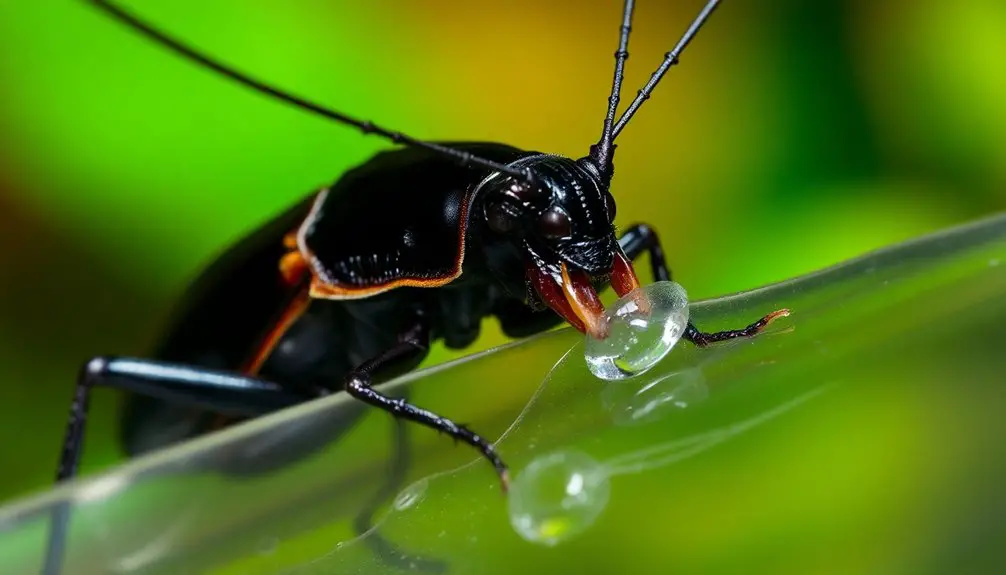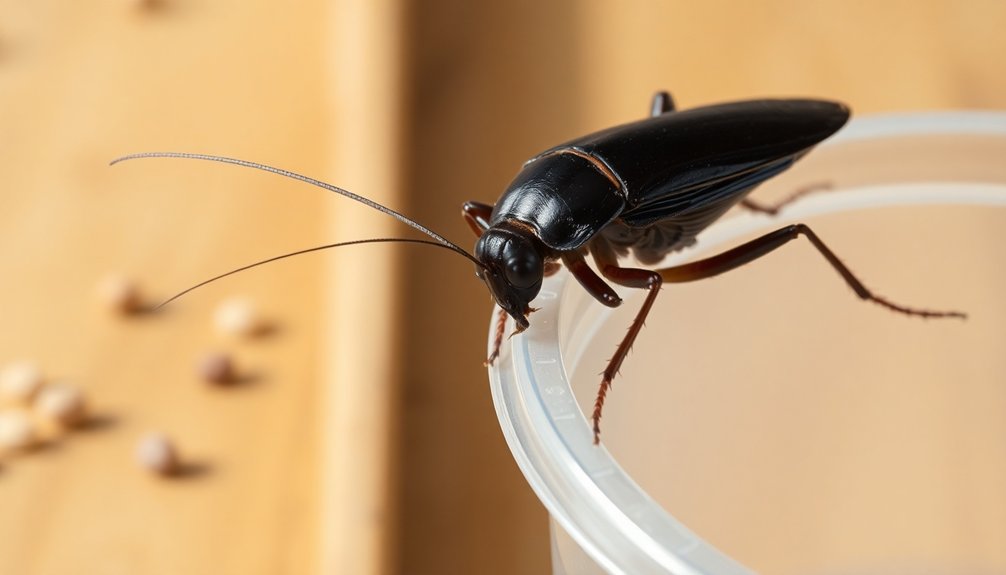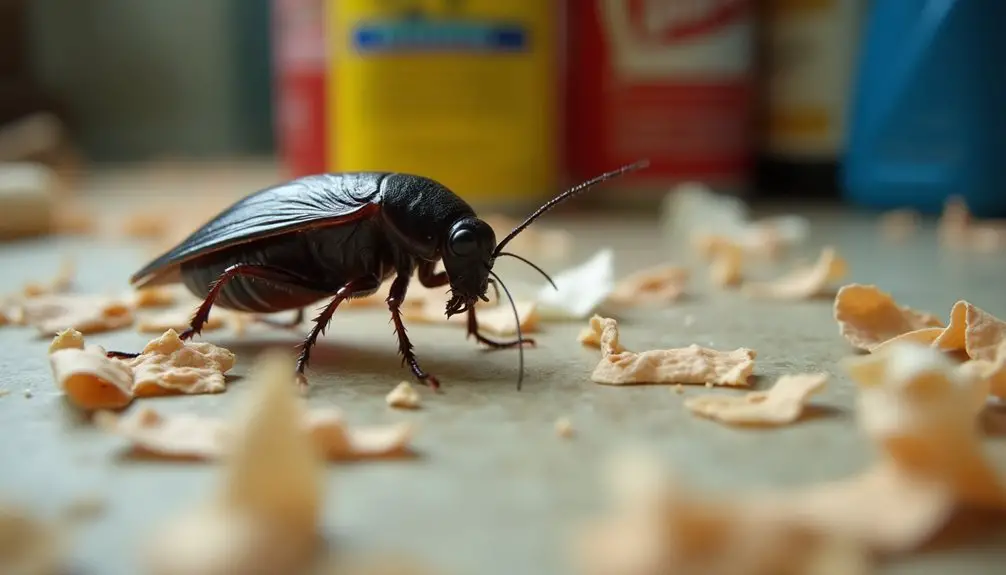Yes, roaches can navigate through plastic surfaces, especially if food residues are present. They're attracted to creases and folds in plastic bags, which provide excellent hiding spots. While they can't eat through most plastics, they're drawn to the scents and can make their way into containers if not sealed properly. To prevent infestations, use airtight containers for food, seal trash bags tightly, and keep your home clean. Regular vacuuming helps eliminate food scraps that attract them. Want to learn more about effective pest control and prevention strategies for your home?
Key Takeaways
- Cockroaches can navigate and hide in plastic, but they do not typically eat through it like they do with organic materials.
- Certain species of cockroaches, like Blaptica dubia, can digest polystyrene, aiding in plastic biodegradation.
- To prevent roach attraction, store food in airtight containers and seal trash bags tightly.
- Regular cleaning and decluttering reduce hiding spots and food residues that attract cockroaches.
- Using durable storage options, like glass, minimizes potential nesting sites for roaches in your home.
Attraction to Plastic
Why are cockroaches so drawn to plastic? One of the main reasons is food residues. If you leave food in plastic bags, roaches can easily detect these remnants and are lured to feast.
Additionally, the creases and folds in plastic bags provide perfect hiding spots. These areas offer shelter and security, making them ideal for roaches to nest. Cluttered environments increase hiding spots for roaches, allowing them to thrive in your home.
Moreover, plastic bags used for food storage or as trash liners often contain organic waste, which intensifies their attraction. Warm and sheltered spots, like the space between your refrigerator and a wall, can also create a cozy environment for roaches.
Cluttered plastic materials, such as stacks of unused grocery bags, give roaches multiple opportunities to establish nests, further increasing their likelihood of infestation.
Certain types of plastic, like grocery bags and chip bags, are particularly enticing due to leftover food residues. Even food storage containers can attract pests if not cleaned properly.
Interaction With Plastic
Cockroaches have a knack for interacting with plastic in ways that can lead to infestations in your home. They love to hide in the creases and folds of plastic bags, using them as perfect shelters. The flexibility of these bags allows cockroaches to easily stack and fold them, creating numerous hiding spots. This provides them protection from predators, making unused grocery bags or plastic trash liners ideal nesting sites. It's also worth noting that the use of safety cutlery can reduce self-harm risks, but this is not directly applicable to cockroach infestations.
Their climbing ability means they can easily navigate rough plastic surfaces to find food sources or secure hiding places. Small crevices in plastic bags serve as entry points, while the moisture retention in these bags attracts them further. Interestingly, many cockroach species are crucial decomposers that help in breaking down organic matter, which highlights their ecological significance even when they invade human spaces.
If you have cluttered plastic materials lying around, you're inadvertently creating opportunities for cockroach nests. To manage potential infestations, seal plastic containers with tight-fitting lids and regularly inspect items like electronics for signs of activity. Discard any heavily infested items, and consider using clear plastic bags for easy monitoring.
Digestion of Plastic

The surprising ability of cockroaches to interact with plastic doesn't stop at hiding in it; they can actually digest certain types of plastic. Specifically, cockroaches like Blaptica dubia can biodegrade polystyrene through enzymatic digestion. Within just 24 hours, they can digest up to 46.6% of ingested polystyrene, showcasing their remarkable efficiency. This ability is particularly noteworthy when considering the chemical properties of plastics like polypropylene, which has a high tensile strength that makes it resistant to degradation.
When you consider their digestion process, it's fascinating that cockroaches possess enzymes capable of breaking down plastics. These enzymes play a crucial role, allowing the cockroach to metabolize the plastic. Approximately 4,600 species of cockroaches exist, demonstrating a wide range of adaptations that contribute to their ecological success.
While they can ingest small pieces of plastic, it's not their preferred food source. Instead, this ability may serve as a survival mechanism, especially in environments where food is scarce.
As they break down plastic, cockroaches contribute to the ecosystem by helping reduce waste. However, the digestion of plastics poses no significant health risks to them, as it's part of their natural metabolic process.
This unique capability highlights the specialized digestive systems of cockroaches and opens doors for future research on their potential role in waste management. Understanding this could offer insights into tackling plastic pollution.
Prevention Methods
Preventing cockroach infestations starts with implementing effective strategies to make your home less inviting to these pests.
Begin by sealing food in airtight containers. This denies roaches access to their primary food source. Also, use tightly sealed trash bags and ensure your trash containers have snug lids to keep them out. It is essential to properly dispose of plastic bags, which can be done through designated recycling programs to prevent attracting pests.
When it comes to storage, opt for durable plastics or glass containers, as these materials are less likely to attract roaches. Avoid using cardboard boxes for long-term storage, as they provide perfect hiding spots. Additionally, using plastic bins with sealed lids can help prevent roach entry during your move.
It's crucial to maintain cleanliness in your home. Regularly vacuum to remove crumbs and food particles, and clean plastic containers after use to prevent residue buildup.
Reduce clutter by recycling old newspapers and bottles, which can serve as roach habitats.
Lastly, regularly check your storage areas for signs of roach activity. If you notice any, address it quickly to prevent a larger infestation.
Roach Behavior and Attraction

Understanding roach behavior is crucial for effective pest control, as these creatures exhibit specific patterns that make them particularly attracted to human environments. You'll find that roaches aren't just after food; they seek shelter and have unique social behaviors that enhance their survival, often thriving in areas with high levels of plastic pollution. Here are three key aspects that attract roaches:
- Food Sources: Roaches are drawn to food residues, especially in plastic bags. They thrive on the smell of rot and decay, making kitchens a prime target.
- Hiding Spots: The creases and folds in plastic bags create perfect hiding spaces. Roaches prefer dark, sheltered areas, often using these spots for protection from predators. Research has shown that cockroaches exhibit unique behavioral patterns influencing their responses to environmental stimuli.
- Social Interaction: Roaches communicate using pheromones, following trails left by others to find food and shelter. Their group behavior allows them to make collective decisions about resources.
Frequently Asked Questions
Can Roaches Damage Plastic Containers Over Time?
Yes, roaches can damage plastic containers over time, especially if they're thin or have food residues. Regular cleaning and using airtight, durable containers will help prevent infestations and protect your belongings from potential harm.
How Do I Identify a Roach Infestation in My Home?
To identify a roach infestation, look for droppings, foul odors, shed skins, and egg capsules. Check dark, damp areas, especially at night. If you notice these signs, it's time to take action.
Are Certain Plastic Types More Appealing to Roaches?
Certain plastic types can attract roaches, especially if they contain food residues. Grocery and chip bags provide hiding spots, while flexible plastics offer shelter, making these materials appealing for roaches seeking food and safety.
What Are the Signs of Roaches Nesting in Plastic?
You'll notice signs of roaches nesting in plastic if you see droppings, egg cases, or physical evidence like shedded skin. Check tight spaces, dark areas, and cluttered spots for these indicators to confirm their presence.
Can Roaches Survive in Extreme Temperatures Inside Plastic?
Roaches can survive extreme temperatures inside plastic. They thrive in warmth and can handle high heat but perish in freezing conditions. Ensure you eliminate moisture and food sources to prevent their survival in your space.

